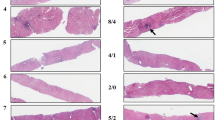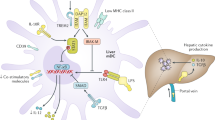Abstract
Liver transplantation is a life-saving therapy to correct liver failure, portal hypertension and hepatocellular carcinoma arising from hepatitis C infection. But despite the successful use of living donors and improvements in immunosuppression and antiviral therapy, organ demand continues to outstrip supply and recurrent hepatitis C with accelerated progression to cirrhosis of the graft is a frequent cause of graft loss and the need for retransplantation. Appropriate selection of candidates and timing of transplantation, coupled with better pre- and post-transplant antiviral therapy, are needed to improve outcomes.
This is a preview of subscription content, access via your institution
Access options
Subscribe to this journal
Receive 51 print issues and online access
$199.00 per year
only $3.90 per issue
Buy this article
- Purchase on Springer Link
- Instant access to full article PDF
Prices may be subject to local taxes which are calculated during checkout




Similar content being viewed by others
References
Brown, R. S. Jr & Lake, J. R. The survival impact of liver transplantation in the MELD era, and the future for organ allocation and distribution. Am. J. Transplant. 5, 203–204 (2005).
Olthoff, K. M. et al. Summary report of a national conference: evolving concepts in liver allocation in the MELD and PELD era. Liver Transplant. 10, A6–A22 (2004).
Lucey, M. R. et al. Minimal criteria for placement of adults on the liver transplant waiting list: a report of a national conference organized by the American Society of Transplant Physicians and the American Association for the Study of Liver Diseases. Liver Transplant. Surg. 3, 628–637 (1997).
Merion, R. M. et al. The survival benefit of liver transplantation. Am. J. Transplant. 5, 307–313 (2005).
Desai, N. M. et al. Predicting outcome after liver transplantation: utility of the model for end-stage liver disease and a newly derived discrimination function. Transplantation 77, 99–106 (2004).
Abt, P. L. et al. Allograft survival following adult-to-adult living donor liver transplantation. Am. J. Transplant. 4, 1302–1307 (2004).
Broelsch, C. E. et al. Liver transplantation in children from living related donors. Surgical techniques and results. Ann. Surg. 214, 428–437 (1991).
Brown, R. S. Jr et al. A survey of liver transplantation from living adult donors in the United States. N. Engl. J. Med. 348, 818–825 (2003).
Liu, C. L., Lam, B., Lo, C. M. & Fan, S. T. Impact of right-lobe live donor liver transplantation on patients waiting for liver transplantation. Liver Transplant. 9, 863–869 (2003).
Russo, M. W., LaPointe-Rudow, D., Kinkhabwala, M., Emond, J. & Brown, R. S. Jr Impact of adult living donor liver transplantation on waiting time survival in candidates listed for liver transplantation. Am. J. Transplant. 4, 427–431 (2004).
Everson, G. T. Treatment of patients with hepatitis C virus on the waiting list. Liver Transplant. 9, S90–S94 (2003).
Marcos, A. et al. Liver regeneration and function in donor and recipient after right lobe adult to adult living donor liver transplantation. Transplantation 69, 1375–1379 (2000).
Baltz, A. C. & Trotter, J. F. Living donor liver transplantation and hepatitis C. Clin. Liver Dis. 7, 651–665, viii (2003).
Russo, M. W., Galanko, J., Beavers, K., Fried, M. W. & Shrestha, R. Patient and graft survival in hepatitis C recipients after adult living donor liver transplantation in the United States. Liver Transplant. 10, 340–346 (2004).
Shiffman, M. L. et al. Histologic recurrence of chronic hepatitis C virus in patients after living donor and deceased donor liver transplantation. Liver Transplant. 10, 1248–1255 (2004).
Gaglio, P. J. et al. Increased risk of cholestatic hepatitis C in recipients of grafts from living versus cadaveric liver donors. Liver Transplant. 9, 1028–1035 (2003).
Freeman, R. B. The impact of the model for end-stage liver disease on recipient selection for adult living liver donation. Liver Transplant. 9, S54–S59 (2003).
Trotter, J. F. et al. Evaluation of 100 patients for living donor liver transplantation. Liver Transplant. 6, 290–295 (2000).
Rudow, D. L., Russo, M. W., Hafliger, S., Emond, J. C. & Brown, R. S. Jr Clinical and ethnic differences in candidates listed for liver transplantation with and without potential living donors. Liver Transplant. 9, 254–259 (2003).
Miller, C. et al. Fulminant and fatal gas gangrene of the stomach in a healthy live liver donor. Liver Transplant. 10, 1315–1319 (2004).
Russo, M. W. & Brown, R. S. Jr Adult living donor liver transplantation. Am. J. Transplant. 4, 458–465 (2004).
Charlton, M. Natural history of hepatitis C and outcomes following liver transplantation. Clin. Liver Dis. 7, 585–602 (2003).
Garcia-Retortillo, M. et al. Hepatitis C virus kinetics during and immediately after liver transplantation. Hepatology 35, 680–687 (2002).
Berenguer, M. Natural history of recurrent hepatitis C. Liver Transplant. 8, S14–S18 (2002).
Berenguer, M. et al. Natural history of clinically compensated hepatitis C virus-related graft cirrhosis after liver transplantation. Hepatology 32, 852–858 (2000).
Cescon, M. et al. Long-term survival of recipients of liver grafts from donors older than 80 years: is it achievable? Liver Transplant. 9, 1174–1180 (2003).
Zhao, Y., Lo, C. M., Liu, C. L. & Fan, S. T. Use of elderly donors (> 60 years) for liver transplantation. Asian J. Surg. 27, 114–119 (2004).
Machicao, V. I. et al. Donor age affects fibrosis progression and graft survival after liver transplantation for hepatitis C. Transplantation 77, 84–92 (2004).
Arenas, J. I., Vargas, H. E. & Rakela, J. The use of hepatitis C-infected grafts in liver transplantation. Liver Transplant. 9, S48–S51 (2003).
Saab, S. et al. Outcomes of hepatitis C and hepatitis B core antibody-positive grafts in orthotopic liver transplantation. Liver Transplant. 9, 1053–1061 (2003).
Saab, S. et al. Hepatitis C positive grafts may be used in orthotopic liver transplantation: a matched analysis. Am. J. Transplant. 3, 1167–1172 (2003).
Charlton, M. et al. Predictors of patient and graft survival following liver transplantation for hepatitis C. Hepatology 28, 823–830 (1998).
Charlton, M. et al. Long-term results and modeling to predict outcomes in recipients with HCV infection: results of the NIDDK liver transplantation database. Liver Transplant. 10, 1120–1130 (2004).
Ghobrial, R. M. et al. A 10-year experience of liver transplantation for hepatitis C: analysis of factors determining outcome in over 500 patients. Ann. Surg. 234, 384–393; discussion 393–394 (2001).
Terrault, N. A. Hepatitis C virus and liver transplantation. Semin. Gastrointest. Dis. 11, 96–114 (2000).
Zervos, X. A. et al. Comparison of tacrolimus with microemulsion cyclosporine as primary immunosuppression in hepatitis C patients after liver transplantation. Transplantation 65, 1044–1046 (1998).
Wiesner, R. et al. A randomized double-blind comparative study of mycophenolate mofetil and azathioprine in combination with cyclosporine and corticosteroids in primary liver transplant recipients. Liver Transplant. 7, 442–450 (2001).
Jain, A. et al. A prospective randomized trial of mycophenolate mofetil in liver transplant recipients with hepatitis C. Liver Transplant. 8, 40–46 (2002).
Nelson, D. R. et al. Anti-interleukin-2 receptor therapy in combination with mycophenolate mofetil is associated with more severe hepatitis C recurrence after liver transplantation. Liver Transplant. 7, 1064–1070 (2001).
Charlton, M. & Seaberg, E. Impact of immunosuppression and acute rejection on recurrence of hepatitis C: results of the National Institute of Diabetes and Digestive and Kidney Diseases Liver Transplantation Database. Liver Transplant. Surg. 5, S107–S114 (1999).
Eason, J. D., Nair, S., Cohen, A. J., Blazek, J. L. & Loss, G. E. Jr. Steroid-free liver transplantation using rabbit antithymocyte globulin and early tacrolimus therapy. Transplantation 75, 1396–1369 (2003).
Shiffman, M. L. et al. Peginterferon α2a and ribavirin in patients with chronic hepatitis C who have failed prior treatment. Gastroenterology 126, 1015–1023 (2004).
Crippin, J. S., McCashland, T., Terrault, N., Sheiner, P. & Charlton, M. R. A pilot study of the tolerability and efficacy of antiviral therapy in hepatitis C virus-infected patients awaiting liver transplantation. Liver Transplant. 8, 350–355 (2002).
Everson, G. T. Should we treat patients with chronic hepatitis C on the waiting list? J. Hepatol. 42, 456–462 (2005).
Everson, G. T. Treatment of chronic hepatitis C in patients with decompensated cirrhosis. Rev. Gastroenterol. Disord. 4 (suppl. 1), S31–S38 (2004).
Gane, E. Treatment of recurrent hepatitis C. Liver Transplant. 8, S28–S37 (2002).
Ahmad, J., Dodson, S. F., Demetris, A. J., Fung, J. J. & Shakil, A. O. Recurrent hepatitis C after liver transplantation: a nonrandomized trial of interferon α alone versus interferon α and ribavirin. Liver Transplant. 7, 863–869 (2001).
Lavezzo, B. et al. Treatment of recurrent hepatitis C in liver transplants: efficacy of a six versus a twelve month course of interferon α2b with ribavirin. J. Hepatol. 37, 247–252 (2002).
Samuel, D. et al. Interferon-α2b plus ribavirin in patients with chronic hepatitis C after liver transplantation: a randomized study. Gastroenterology 124, 642–650 (2003).
Chalasani, N. et al. Peginterferon α2a for hepatitis C after liver transplantation: two randomized, controlled trials. Hepatology 41, 289–298 (2005).
Rodriguez-Luna, H. et al. Treatment of recurrent hepatitis C infection after liver transplantation with combination of pegylated interferon α2b and ribavirin: an open-label series. Transplantation 77, 190–194 (2004).
Ross, A. S. et al. Pegylated interferon α2b plus ribavirin in the treatment of post-liver transplant recurrent hepatitis C. Clin. Transplant. 18, 166–173 (2004).
Saab, S. et al. Outcomes of acute rejection after interferon therapy in liver transplant recipients. Liver Transplant. 10, 859–867 (2004).
Toniutto, P. et al. Pegylated versus standard interferon-α in antiviral regimens for post-transplant recurrent hepatitis C: comparison of tolerability and efficacy. J. Gastroenterol. Hepatol. 20, 577–582 (2005).
Stravitz, R. T. et al. Effects of interferon treatment on liver histology and allograft rejection in patients with recurrent hepatitis C following liver transplantation. Liver Transplant. 10, 850–858 (2004).
Wiesner, R. H., Sorrell, M. & Villamil, F. Report of the first International Liver Transplantation Society expert panel consensus conference on liver transplantation and hepatitis C. Liver Transplant. 9, S1–S9 (2003).
Author information
Authors and Affiliations
Ethics declarations
Competing interests
The author declares no competing financial interests.
Additional information
Author Information Reprints and permissions information is available at npg.nature.com/reprintsandpermissions.
Rights and permissions
About this article
Cite this article
Brown, R. Hepatitis C and liver transplantation. Nature 436, 973–978 (2005). https://doi.org/10.1038/nature04083
Published:
Issue Date:
DOI: https://doi.org/10.1038/nature04083
This article is cited by
-
Impact of Behavioral Health Consultation on Hepatitis C Treatment Outcomes at a Federally Qualified Health Center; Philadelphia, PA
The Journal of Primary Prevention (2021)
-
5-Oxo-1-[(2,3,6,7-tetramethoxy-9-phenanthrenyl)methyl]-L-proline Inhibits Hepatitis C Virus Entry
Scientific Reports (2019)
-
Efficacy and safety of the new antiviral agents for the treatment of hepatitis C virus infection in Egyptian renal transplant recipients
International Urology and Nephrology (2019)
-
Modelling the burden of hepatitis C infection among people who inject drugs in Norway, 1973–2030
BMC Infectious Diseases (2017)
-
Identification of a flavonoid isolated from plum (Prunus domestica) as a potent inhibitor of Hepatitis C virus entry
Scientific Reports (2017)
Comments
By submitting a comment you agree to abide by our Terms and Community Guidelines. If you find something abusive or that does not comply with our terms or guidelines please flag it as inappropriate.



